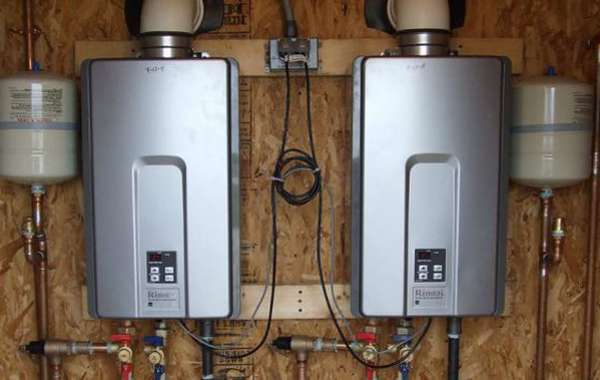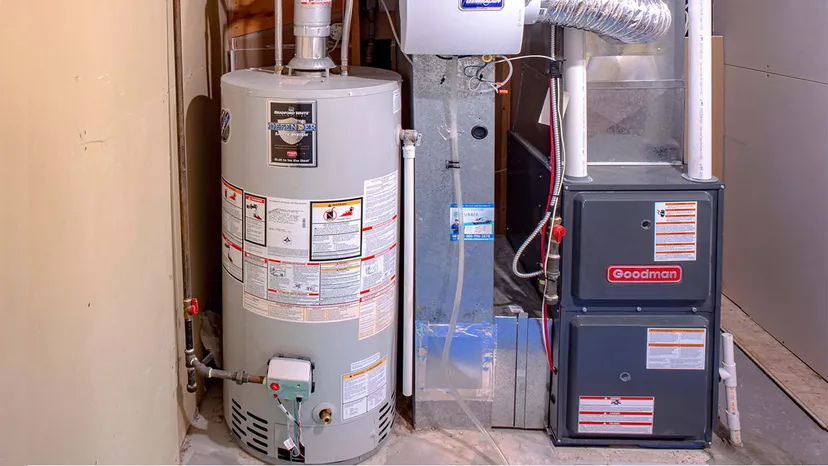The specifics of each type of water heater implies its pros and cons, as well as the features of care. Of course, each model has its own additional features, parameters and characteristics. Here is the most general, basic principle of operation and arrangement of units for heating water.

Instantaneous water heater device
Electric and gas instantaneous water heaters have a number of common features based on a similar principle of operation.
Water in these devices does not linger, but directly from the water supply enters the water intake point (shower or faucet), having previously heated up during movement through the heating element. It is a heating element – if these are electric water heaters, or a heat exchanger – if they are gas. The main point is the performance and power of the devices. How much water can be produced by the device per unit time and, accordingly, the water temperature depends on these characteristics.
Instantaneous water heaters can be of various configurations. According to the structure diagram, the flow apparatus has the following components:
- Exhaust pipeInstantaneous water heater device
heat exchanger - Gas-burner
- Fan (draft former)
- Remote Control
flow sensor - Hot water to the faucet
- Gas supply
- Cold water supply
- Cold water to the faucet
The principle of operation of instantaneous water heaters can be carried out in two ways: pressure or non-pressure, and, accordingly, they are divided into two types – single-phase and three-phase. Pressure or three-phase units are capable of serving both one and several water intake points at once. Their principle of operation is based on the pressure at the entrance to the device and inside it. And non-pressure or single-phase units, as a rule, deal with only one water intake point, they operate at pressure only at the inlet to the water heater.
Heating element
The heating element in electric instantaneous water heaters is the so-called heating element or thermal electric heater, which can be of a “wet” and “dry” type. A “wet” type heating element assumes its direct contact with water, which, on the one hand, produces the highest quality water heating and saves electricity, and on the other hand, increases the risk of electric shock in case of malfunctions. While the “dry” type heating element assumes the presence of an air space between the heating element and water, the heating element in such devices is enclosed in a metal flask. Supporters of the “wet” type believe that this option is inefficient, because air is considered to be a heat insulator. However, the specialists developing the “dry” method speak of the high quality of work, thanks to new technologies and progressive tool designs.
Burner
If we talk about gas instantaneous water heaters, then here the gas burner acts as a heating element. You can ignite gas in different ways, depending on the model of the device, however, today columns with automatic or electronic ignition are considered more popular, although models with a “button” or a piezo for igniting gas are not a thing of the past. With electric ignition, the flame is automatically generated when the water is turned on and dies out when it is turned off. Such devices are able to independently resume operation during power outages. The only downside is that you have to change the batteries.
In a gas flow unit, the water temperature depends on its volume, as well as the power of the tool. You can adjust the power yourself, however, if you increase the water pressure or turn on another tap somewhere, the water temperature will drop. Developments do not stand still, and already models of gas instantaneous water heaters with a modulating burner are able to independently regulate the power so that there are no sudden drops.
Water, heating up, passes through a heat exchanger, the quality of which is very important for a geyser. A steel heat exchanger will allow you to save on purchase, but will significantly reduce the service life. The copper heat exchanger is rightfully considered the best, which increases not only the service time, but also the efficiency of the unit.
And what happens to the products of combustion, because we are dealing with gas, not electricity? There are two types of water heaters: with open and closed combustion chambers. An open combustion chamber involves the exit of waste into the chimney, and a closed one – the forced removal of products into a special device (coaxial chimney).
It is important that such a device is very responsive to strong drops in water pressure.

Regulatory and protective elements
To regulate the temperature and control the operation of the water heater is the function of the thermostat. It is he who protects the device from overheating and unforeseen breakdowns. The adjustment system is as follows: you yourself set the temperature you need using the thermostat, and the thermostat automatically maintains it until you want to change it again. If the water level drops by less than 3-5%, the thermostat turns off the device, or rather, stops the heating element.
A very important element in both electric and gas water heaters is the magnesium anode. It protects almost all elements from corrosion. Without it, the units would serve no more than six months, it is after such a time that the anode should be periodically changed.
But to protect the device, the internal coating of the tank also plays an important role. It can be made of glass porcelain, enamel, high-temperature ceramics, polyurethane foam or other material.
Thermal insulation of the tank is also necessary, the higher and better it is, the less heat loss and the cost of heating water. Thermal insulation plays a special role, of course, in storage water heaters.
Their power can be absolutely anything, it can be 3300 W, as, for example, in the Ariston Bravo M 3323 U-PV1 model or 25.1 W in the Bosch WST 120 RO model, or it can be 26200 W, as in the Bosch GWH 15 models -2 COD H and Bosch GWH 15-2 CO P. The performance of the water heater is recognized by the “minimum water flow” characteristic. So the Termex ID 80 H (RZB80-D) model with a power of 2000 W has a minimum water flow of 6 l / min. Some devices also contain information about the maximum heating temperature, for example, in Termex ID 80 H (RZB80-D) it is 60 degrees C.
Storage water heaters
The scheme of the storage water heater looks something like this:
- frame;
- tank protected by a special coating;
- magnesium anode;
- thermal insulation;
- combustion chamber, open or closed type, or electric heater;
- thermostat;
- for gas units, an exhaust hood, a gas burner;
- Control block;
- protection system;
- temperature sensor;
- safety valve;
- electric cable (for electric models);
- indicator lamp.
The principle of operation of storage water heaters is based on the fact that cold and hot water have different densities. So in the apparatus it is located in layers, at the bottom – cold (it has a high density), at the top – hot. Cold water enters and, without mixing with hot water, pushes it to the water intake point. In this regard, you get a continuous flow of consistently hot water, without any interruptions in operation and unnecessary costs. Water heating is carried out thanks to a heating element or a gas burner, depending on the type of apparatus. Accumulative models will provide consistently hot water from several water intake points.
